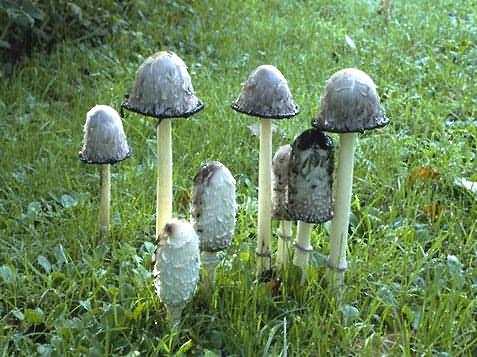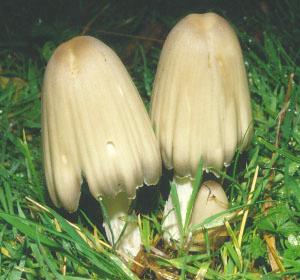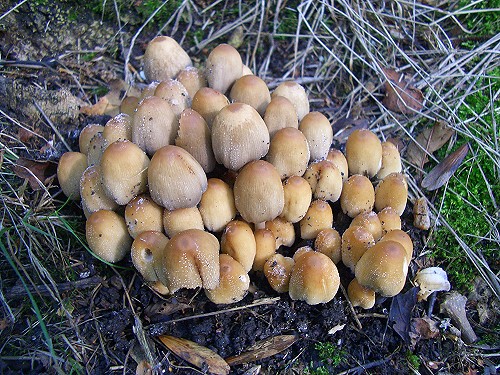Elite life

Mushrooms
Coprinus
║ Mushrooms ║
Shaggy Ink Cap (Coprinus comatus)

Cap: 3-15 cm; oval to rounded-cylindrical when young, expanding to bell-shaped with a lifting margin; in age turning to black "ink"; dry; whitish with a brownish center; with large, shaggy scales; margin lined at maturity.
Gills: Free from the stem; white, becoming pinkish, then black; turning to black "ink"; very crowded.
Stem: 5-20 cm long; 1-2 cm thick; frequently tapering to apex; smooth; white; easily separable from cap; hollow, with a string-like strand of fibers hanging inside.
Flesh: White throughout; soft.
Alcohol Inky (Coprinus atramentarius, Coprinopsis atramentaria)

Cap 3-7 cm high, ovoid at first, then broadly conical when expanded, with the margin irregularly puckered at first, then becoming split; gray to gray-brown; dry, smooth or silky with minute scales or veil remnants, especially near the center. Gills free, crowded, broad; white then lavender-gray then inky black and soon deliquescing. Stem 70-170 x 9-20 mm, hollow; whitish; dry, silky-fibrous; fibrous white partial veil leaving ring zone near base. Odor faint and pleasant or none. Spores ellipsoid, smooth, with pore at tip, 7-11 x 4-6 μm. Deposit black. Habitat usually in clusters on the ground near rotting or buried wood or in grass.
Fairy Ink Cap (Coprinus disseminatus)
Cap 0.5-1.5cm high, ovoid at first, expanding to convex or bell-shaped; pale buff with buff or honey-buff center; deeply grooved, minutely scruffy. Gills attached, nearly distant, broad; white then amber to black, but not inky or deliquescing. Stem 15-40 x 1-3mm, hollow, fragile; white with a buff tinge near the base, which is covered in white down; smooth to minutely hairy. Flesh fragile. Odor none. Spores ellipsoid to almond-shaped, smooth, 7-9.5 x 4-5?. Deposit dark brown or blackish. Dermatocystidia thin-walled, blunt, cylindrical, with a swollen base, 75-100 x 20-30 μm.
Glistening Ink Cap (Coprinus micaceus)

Cap: 2-15 cm, oval when young, expanding to broadly convex or bell-shaped, sometimes with a curled up and/or tattered margin; honey brown, tawny, amber, or sometimes paler; becoming paler with age, especially towards the margin; buttons covered with mica-like granules which frequently wash off with rain or dew; the margin lined or grooved, usually halfway towards the center or more.
Gills: Attached to the stem or free from it; pale, becoming brown, then black; deliquescing (turning to black "ink") but usually not completely; close or crowded.
Stem: 2-8 cm long; 3-6 mm thick; equal; smooth to very finely hairy or granulated; white; fibrous; hollow.
Flesh: White to pale throughout; thin; soft.
║ Mushrooms ║